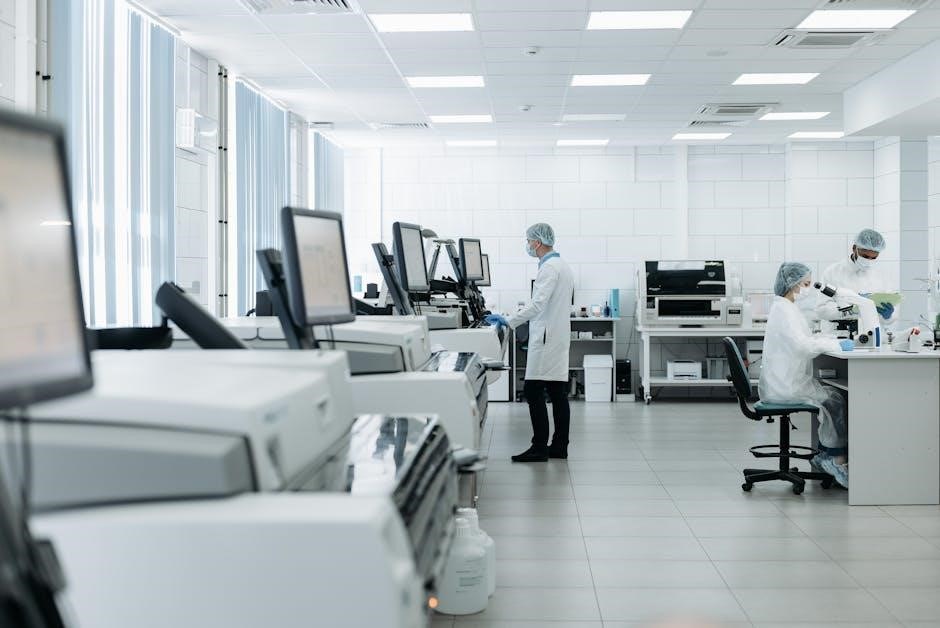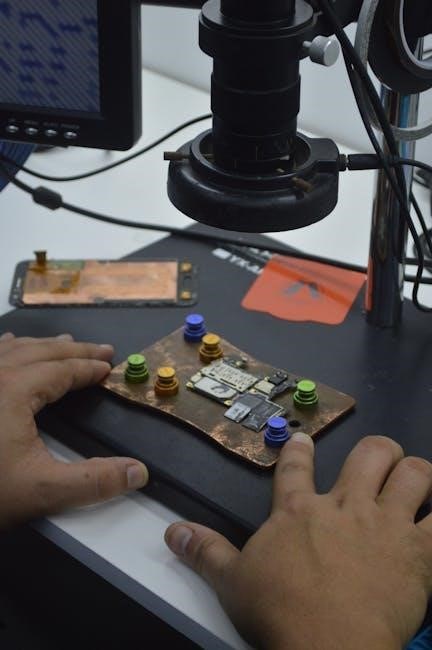Bausch & Lomb ISTX8L Microscope Manual PDF: An Overview
The Bausch & Lomb ISTX8L microscope is a piece of equipment. The manual offers guidance, maintenance and other accessories. Many sites offer manuals and guides online for download in PDF form, ensuring accessibility for users.
Availability of ISTX8L Manuals
Finding the Bausch & Lomb ISTX8L microscope manual can be achieved through multiple avenues. Online platforms, such as eBay, often list manuals and books for Bausch & Lomb test equipment, including microscopes. These resources may be available for purchase or as free downloads, depending on the seller or website. Moreover, specialized forums and communities dedicated to microscope enthusiasts frequently share scanned copies of original manuals. These community-driven efforts ensure that valuable documentation is preserved and accessible. Websites hosting collections of microscope manuals, brochures, and catalogs may also contain the ISTX8L manual or related documents. For instance, websites dedicated to science and laboratory equipment sometimes feature indexed documents for various Bausch & Lomb products. You can also find manuals on sites, where users can publish documents, ensuring high visibility and many readers. The Bausch & Lomb Library may also contain manuals and printed inserts from the R1900. When searching online, it’s helpful to use specific keywords such as “Bausch & Lomb ISTX8L manual PDF” to narrow down results. Additionally, checking repositories like GitHub, where users upload and share technical documents, can be a fruitful approach. Remember to verify the authenticity and completeness of any downloaded manual to ensure it accurately represents the ISTX8L microscope.

Bausch & Lomb Microscope Manuals: General Information
Bausch & Lomb microscope manuals contain essential details. The manuals provide instructions for use, maintenance and troubleshooting and also include maintenance, assembly, and safety. They are made to enhance user experience.
Types of Manuals Available
Bausch & Lomb offers a variety of manuals to support its range of microscope products. These manuals cater to different needs, including user manuals, repair manuals, and reference manuals. User manuals provide detailed instructions on how to operate and maintain the microscopes, ensuring users can properly assemble, use, and troubleshoot their equipment. Repair manuals are designed for technicians and provide in-depth guidance on diagnosing and fixing technical issues. They often include schematics, parts lists, and step-by-step repair procedures. Reference manuals offer additional information, such as specifications, safety guidelines, and detailed explanations of microscope components and their functions. These manuals are valuable resources for both beginners and experienced users, helping them to understand and maximize the performance of their Bausch & Lomb microscopes. In addition to these primary types, there are also catalogs and brochures that provide overviews of available models and accessories. These documents can assist users in selecting the right equipment for their specific needs. Whether you are a student, researcher, or technician, having access to the appropriate manual can significantly enhance your ability to effectively use and maintain your Bausch & Lomb microscope.

Bausch & Lomb StereoZoom Microscopes: Manuals and Instructions
Bausch & Lomb StereoZoom microscopes come with manuals that offer instructions on how to properly use, assemble, and maintain the equipment. These manuals ensure users can maximize the microscope’s functionality.
Instructions on Use, Assembly and Maintenance
The Bausch & Lomb StereoZoom microscope manuals provide detailed instructions on use, assembly, and maintenance. To start using the StereoZoom microscope, users should first unpack it carefully, ensuring all components are present. The assembly instructions guide users through the proper setup of the microscope, including attaching the necessary objectives and eyepieces. These instructions often include diagrams and step-by-step explanations to facilitate correct assembly, even for those unfamiliar with microscope components. Proper assembly is crucial for optimal performance and accurate observations. The manuals also cover the correct operation of the microscope, detailing how to adjust focus, illumination, and magnification to achieve the desired image quality. Users are instructed on how to position samples correctly and use the various controls to enhance visibility and clarity. Furthermore, the manuals emphasize safety precautions to prevent damage to the microscope and ensure user safety during operation. Maintenance is another critical aspect covered in the manuals. Regular cleaning and care are essential to prolong the life of the microscope and maintain its performance. The manuals provide guidance on cleaning the lenses and other components, as well as lubricating moving parts. They also outline troubleshooting steps to address common issues, such as blurry images or malfunctioning controls. By following the instructions in the manual, users can ensure their Bausch & Lomb StereoZoom microscope remains in excellent condition and provides reliable performance for years to come. Additionally, the manuals often include information on available accessories and how to integrate them with the microscope for specialized applications.
Bausch & Lomb Microscope Objectives: Design and Usage
Bausch & Lomb microscope objectives are designed with precision to meet the demands of various microscopy applications. These objectives are crafted to deliver high-quality images with exceptional clarity and resolution. The design incorporates advanced optical elements that minimize aberrations and distortions, ensuring accurate and detailed observations. Different objectives are available to suit specific magnification needs, ranging from low-power objectives for wide-field viewing to high-power objectives for detailed examination of minute structures. Each objective is carefully engineered to provide optimal performance within its designated magnification range. The numerical aperture (NA) of the objective is a critical parameter that determines its light-gathering ability and resolving power. Objectives with higher NA values can resolve finer details and produce brighter images, making them ideal for demanding applications such as fluorescence microscopy and live cell imaging. Bausch & Lomb objectives are also designed to be compatible with specific cover glass thicknesses, typically 0.17mm, to ensure optimal image quality. Using the correct cover glass thickness is essential to minimize spherical aberration and maintain image sharpness. The usage of Bausch & Lomb microscope objectives involves selecting the appropriate objective for the desired magnification and resolution, ensuring it is properly mounted on the microscope, and adjusting the focus to achieve a clear image. Proper alignment and care are crucial for maintaining the performance and longevity of these precision optical components. Regular cleaning with appropriate lens cleaning solutions and cloths is recommended to remove dust and debris that can degrade image quality. Furthermore, it is important to avoid touching the lens surfaces with bare fingers, as this can leave behind oils and contaminants. By following these guidelines, users can ensure that their Bausch & Lomb microscope objectives continue to deliver exceptional performance for years to come.
Bausch & Lomb Product Instructions: IFUs, DFUs and Package Inserts
Bausch & Lomb provides comprehensive instructions for use (IFUs), directions for use (DFUs), and package inserts for its wide range of products, spanning contact lenses, lens care solutions, general eye health products, pharmaceuticals, and surgical devices. These documents are essential resources for healthcare professionals and patients, ensuring the safe and effective use of Bausch & Lomb products. IFUs offer detailed guidance on the intended use of a product, including indications, contraindications, warnings, precautions, and potential adverse events. They also provide step-by-step instructions on how to properly use the product, including preparation, administration, and disposal. DFUs are similar to IFUs but may be tailored for specific audiences or products, providing more concise or simplified instructions. Package inserts, found within the product packaging, offer essential information about the product, including its composition, storage conditions, and expiration date. They may also include warnings and precautions related to product use. Bausch & Lomb makes these documents readily available through its website and other channels, ensuring that users can easily access the information they need. A simple search on the Bausch & Lomb website can quickly locate the IFUs, DFUs, and package inserts for specific products. These documents are regularly updated to reflect the latest scientific evidence and regulatory requirements, ensuring that users have access to the most accurate and up-to-date information. By providing clear and comprehensive product instructions, Bausch & Lomb demonstrates its commitment to patient safety and product efficacy.

Finding Bausch & Lomb Manuals Online
Locating Bausch & Lomb manuals online, including those for microscopes like the ISTX8L, involves a strategic approach utilizing various online resources. Start by visiting the official Bausch & Lomb website, which often hosts a comprehensive library of product manuals, instructions for use (IFUs), and other documentation in PDF format. Use the website’s search function, specifying the product name or model number (e.g., “ISTX8L microscope manual”) to narrow down the results. If the official website doesn’t yield the desired manual, explore online repositories and document-sharing platforms. Websites dedicated to scientific equipment or microscope resources may host user-submitted or archived manuals. Additionally, online marketplaces and auction sites, such as eBay, sometimes offer printed or digital copies of Bausch & Lomb manuals for sale. When searching on these platforms, use specific keywords like “Bausch & Lomb microscope manual,” “ISTX8L manual PDF,” or “StereoZoom microscope manual.” Be cautious when downloading manuals from unofficial sources, ensuring the file is from a reputable source and free from malware. Consider consulting online forums and communities dedicated to microscopy or Bausch & Lomb products. Members may be able to provide links to manuals or offer assistance in locating the desired document. Remember to check the manual’s version and applicability to your specific microscope model. By combining these search strategies, you can increase your chances of finding the Bausch & Lomb microscope manual you need.

Bausch & Lomb Microscope History
The history of Bausch & Lomb microscopes is intertwined with the broader narrative of scientific advancement and innovation in optical technology. Founded in 1853 by John Jacob Bausch and Henry Lomb, the company initially focused on producing eyeglasses and other optical products. However, Bausch & Lomb soon expanded its offerings to include microscopes, recognizing their importance in scientific research and education. In the late 19th and early 20th centuries, Bausch & Lomb emerged as a leading manufacturer of microscopes, producing a wide range of models for various applications. Their microscopes were known for their quality optics, precision engineering, and innovative designs. Bausch & Lomb played a crucial role in popularizing microscopy, making it more accessible to researchers, educators, and hobbyists. The company’s StereoZoom microscope, introduced in the mid-20th century, became a particularly iconic product, widely used in laboratories and classrooms around the world. Throughout its history, Bausch & Lomb collaborated with leading scientists and researchers to develop cutting-edge microscope technology. Their contributions to microscopy have had a lasting impact on fields such as biology, medicine, and materials science. While Bausch & Lomb has since diversified its product portfolio, its legacy as a pioneer in microscope technology remains significant. Today, vintage Bausch & Lomb microscopes are highly sought after by collectors and enthusiasts, serving as a reminder of the company’s rich history and contributions to scientific exploration. The availability of manuals and documentation for these historical instruments further enhances their value and utility for researchers and collectors alike. They produced many models including the Model R.
